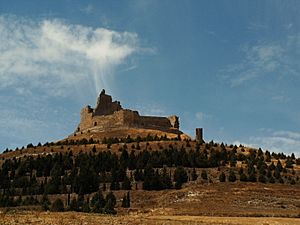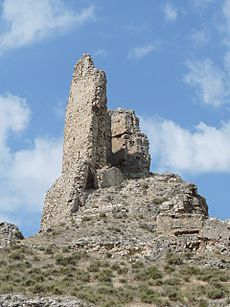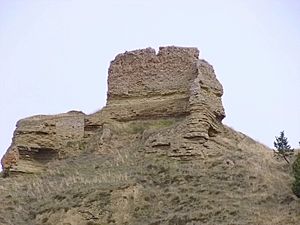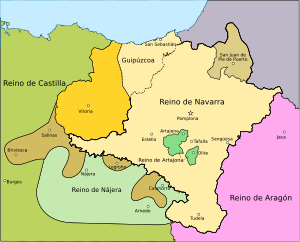Gutierre Fernández de Castro facts for kids
Gutierre Fernández de Castro was an important nobleman and military leader from the Kingdom of Castile in Spain. He lived from about 1100 to 1166. Gutierre served two kings: Alfonso VII (1126–1157) and his son Sancho III (1157–1158). He was a trusted advisor and even served as the king's majordomo (a high-ranking official, like a chief of staff). He also helped teach the young Prince Sancho III.
Gutierre took part in many military campaigns to take back land from the Almoravid rulers in the south of Spain. This period was known as the Reconquista. He also defended Castile's eastern borders from attacks by the kingdoms of Aragon and Navarre. For his loyalty, the king gave him control over many important lands. Even though he was very important and had a great military career, Gutierre was never given the highest noble title of "count." He died before a big rivalry between his family (the Castros) and another powerful family (the Laras) turned into a civil war.
Contents
Family and Early Life
Gutierre was born around the year 1100. He was the oldest son of Fernando García de Hita and his first wife, Tegridia. He had one full brother named Rodrigo Fernández. After 1125, their father is no longer mentioned in historical records. In 1126, after Queen Urraca died, Gutierre and Rodrigo went with their uncle, García Garcés de Aza, to show their loyalty to the new king, Alfonso VII.
Gutierre married Toda Díaz in the early 1120s. She came from a noble family in the county of Álava. In 1124, Gutierre and Toda received some land from Toda's grandmother. In 1125, Gutierre and his wife created a special set of rules, called a fuero, for their estate at San Cebrián de Campos. This fuero explained what the tenants (people living on their land) had to do. For example, they had to work on the lord's land two days a month, doing things like plowing and harvesting. Gutierre also owned land at Castrojeriz, which was his family's traditional home and where the Castro family name came from.
Some historians have confused Gutierre Fernández de Castro with an earlier person also named Gutierre Fernández. However, our Gutierre was too young to have done some of the things attributed to the earlier person, like serving King Alfonso VI.
Serving King Alfonso VII
Gutierre started regularly attending King Alfonso VII's royal court in 1134. From then on, he signed almost 500 royal documents as a witness, showing how often he was with the king. People at the time called him "great in the imperial court."
One of his first important jobs was a diplomatic mission in 1131. He traveled to Rueda de Jalón to meet Sayf al-Dawla, a Muslim ruler who wanted King Alfonso's help against the Almoravids. Gutierre helped arrange for Sayf al-Dawla to come safely to meet King Alfonso.
In early 1135, Gutierre became Alfonso's majordomo, a very important position. He held this job until late 1138. The majordomo was the highest-ranking officer at court, likely in charge of organizing the court and managing the king's lands. This role allowed Gutierre to travel all over Alfonso's kingdom. For example, in 1137, he joined the king's trip to defend Galicia from an invasion by Portugal.
In 1140, Gutierre and his brother Rodrigo witnessed an important treaty between King Alfonso and Raymond Berengar IV of Barcelona. In 1144, Gutierre was likely present when King García Ramírez of Navarre married Alfonso's daughter. Gutierre and another nobleman led the special guard that took the newly married couple back to Navarre.
Gutierre was often at the royal court again in 1146–1147, when Alfonso led a major campaign to retake Muslim territories in the south. In 1152, he was part of the council that helped King Alfonso update the laws for the city of Sahagún.
Lands and Responsibilities
Gutierre was given control over several important areas, called tenencias or fiefs, by the king. These were mostly in eastern Castile, close to the border with Navarre. Because he spent so much time at court and fighting wars, he usually managed these lands from a distance.
One of his first major tenancies was Calahorra, a city that had once belonged to Navarre. He took over Calahorra in 1140. He appointed a local official, Martín Fernández, to help him govern the city. Gutierre continued to hold Calahorra until at least 1152.
He also likely controlled the fortress of Castrojeriz from 1132 until his death. He also held Amaya and Burgos around 1146. Between 1140 and 1150, Gutierre was known as the "lord in Soria" and may have held it until 1152. Around 1148, he also gained control of Roa de Duero.
Later in Alfonso's reign, Gutierre gained control of several areas around Palencia, including Villagarcía de Campos, Monzón de Campos, and Carrión de los Condes. These lands, further from the border, likely provided him with income. Like many nobles, Gutierre used his wealth to donate to churches and monasteries. He and his wife, Toda, helped re-establish two monasteries: San Salvador de El Moral and San Cristóbal de Ibeas.
Gutierre continued to hold Castrojeriz until his death in 1166.
Military Actions
Gutierre's first military actions were in the war against Aragon in the early 1130s. He was at the siege of Castrojeriz in 1131, where Castilian forces made the Aragonese surrender the fortress. By 1133, he led the Castilian armies that captured Belorado, Montes de Oca, and Grañón from Aragon. In 1137, he helped King Alfonso in a successful campaign against the Portuguese in Galicia.
In 1139, Gutierre and his brother Rodrigo were ordered by the king to begin the Siege of Oreja, an Almoravid fortress. They gathered soldiers from different regions, including city militias. The king joined them later with more troops. Gutierre stayed at the siege until the Almoravids surrendered in late 1139.
Gutierre also fought in the war against Navarre in 1140. In 1144, he took part in a royal raid into Almoravid territory. In 1146, he was at the first siege of Córdoba. He also joined the major campaign against Almería in 1147. An old poem, the Poem of Almería, describes Gutierre's personal involvement in the battle with his knights, noting that he was also the royal tutor to Prince Sancho.
In 1150, Gutierre participated in the second siege of Córdoba, and in 1151, he helped besiege Jaén. He likely joined King Alfonso's expedition against other towns in 1155. Even as an old man, in 1159, he defended Calahorra from an Aragonese attack with the militia of Burgos. It is said that during his long military career, he personally knighted as many as 500 men.
Serving King Sancho III
Gutierre had a very close relationship with King Sancho III, which began when Sancho was a child. By 1145, Gutierre and his wife, Toda Díaz, were appointed as tutors to the young Prince Sancho. This meant they were responsible for his education and upbringing.
In 1150, Gutierre continued to help Sancho as the prince began to rule his own sub-kingdom around Nájera. A royal document even called Gutierre the young king's "paranymph," which means a close companion or advisor. By 1153, Gutierre became Sancho's majordomo, just as he had been for Sancho's father.
In 1152, when King Sancho VI of Navarre threatened the Rioja region, King Alfonso VII sent his son Sancho, along with Gutierre and Manrique de Lara, to confront the Navarrese king. The young King Sancho arrived with a large army, which was enough to make the King of Navarre back down without a fight.
Some later historians wrote that Sancho III's favor towards Gutierre caused the rivalry between the Castro and Lara families. Before he died, King Sancho arranged for the control of lands held from the king to be frozen for fifteen years, until his young son, Alfonso VIII, became an adult.
Alfonso VIII and the Castro–Lara Feud
After King Sancho III died in 1158, the guardianship of his young son, Alfonso VIII, was given to Gutierre. However, the regency (the rule of the kingdom while the king was a child) went to Count Manrique Pérez de Lara.
Some stories say that Manrique tricked Gutierre into giving Alfonso to his uncle, García Garcés de Aza, who then gave Alfonso to Manrique. However, Gutierre was an experienced and respected nobleman, so it's unlikely he would have been easily tricked. The young king eventually ended up in Manrique's care.
There is some evidence that the kingdom of Castile was divided between Manrique and Gutierre after Sancho's death. Gutierre was called "the power in Castile," while Manrique ruled in other regions. Gutierre did not join his nephews, the younger Castros, in their fight against the Lara family. He seemed to try to keep the peace and supported Manrique at times. He also helped his nephew, Fernando Rodríguez, return to Castile after a battle.
Gutierre continued to attend the royal court and witness important documents until July 1166. After this, he likely retired to his own lands. He probably held Castrojeriz and Amaya until his death.
The exact date of Gutierre's death is not known, but it was likely in 1166 or shortly after. His wife, Toda, may have died before him. They did not have any surviving children. His large estates and lands were inherited by his nephews. Gutierre was buried in the monastery of San Cristóbal de Ibeas.
 In Spanish: Gutierre Fernández de Castro para niños
In Spanish: Gutierre Fernández de Castro para niños






